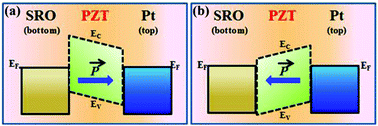An ultrathin flexible electronic device based on the tunneling effect: a flexible ferroelectric tunnel junction†
Abstract
Flexible electronics have attracted long-standing attention in today's energy-conscious world. Among the flexible electronics, the flexible ferroelectric tunnel junction can realize non-destructive readout and consume less energy, and it may be a very promising device owing to the advantages of excellent portability, bendability and being lightweight. However, few flexible ferroelectric tunnel junctions with good performance have been reported because the inorganic materials with good ferroelectric properties always have a high crystallization temperature, which restricts the flexible substrate selection. In this report, we report a flexible ferroelectric tunnel junction that is based on PbZr0.52Ti0.48O3 film grown on mica with a bottom electrode of SrRuO3 film. The flexible ferroelectric tunnel junction of asymmetric structure not only can achieve nondestructive readout, but it also has good bendability. Especially, the on/off ratio of the junction averages about 1.08 × 104%. The application of flexible ultrathin ferroelectric film is beneficial to realize flexible ferroelectric electronic devices that are integrated with flexible circuit systems in modern microelectronics.



 Please wait while we load your content...
Please wait while we load your content...